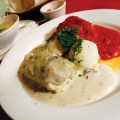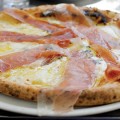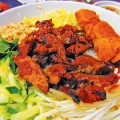If an Italian restaurant can’t make good pasta, what good is it? That was the question I faced at Campbell’s Tigelleria Organic Restaurant.
During three visits, the house-made pasta had the texture of wet cardboard. It was thick, gummy and leaden. A complete failure. And yet in spite of this injustice, the restaurant still has great appeal. It’s an intimate and friendly place with loads of personal touches.
The ingredients are sourced from local and sustainable sources. The staff is friendly and knowledgeable. There’s a great Italian wine list, and if you steer clear of the pasta, there’s plenty of good stuff to eat.
But first let me take up the pasta problem. I don’t know if the pasta was underworked, undercooked or what, but something was seriously wrong. While the fillings and sauces were good, the pasta just fell flat.
Take the wild-boar-stuffed ravioli in a porcini cream sauce. I was excited to see boar on the menu as well as ravioli made with organic flour, but the little bundle of dough was dense and chewy and a real disappointment, a $23 disappointment.
Bigoli is a thick, tubelike pasta that Tigelleria tosses with a delicious duck ragu ($21). The dish had a great, hearty flavor, but the doughy pasta dragged it down. The worst offender was the “cappellacci” di zuca ($20), an unconventional dish made with ring-shaped pasta filled with roasted pumpkin, amaretto cookies, Parmesan cheese and a bit of nutmeg. Never mind that it was too sweet, it was the pasty wad of pasta the really did in this dish.
Fortunately, things looked up once I branched out from the pasta. One of my favorite dishes of the year was the zuppa pavese ($10), a thick slice of crusty, homemade ciabatta bread served in a bowl and topped with an organically raised raw egg and grated Parmesan cheese. The server poured a small pitcher of rich and savory hot meat broth over the bowl and then covered it with a small plate, gently cooking the egg. Wait a few minutes and pierce the yolk to create a truly outstanding bowl of soup that succeeds on the strength of just a few, top-quality ingredients.
My other favorite dish was the sautéed cavolo nero kale ($12). Sometimes called dinosaur kale because it vaguely looks like a crinkly head of a brontosaurus, the kale is tossed with lemon juice, honey, olive oil, mango, pine nuts and gooey Robiola cheese. On paper, I wouldn’t think the mango would work with the other ingredients but the sweetness of the fruit is a perfect foil for the pleasantly bitter bite of the kale.
The tre vinezie ($12) is a good early-winter salad made with red-leaf lettuce, slow-cooked fennel, hazelnut and orange slices tossed with tangerine juice, wine reduction and a dribble of espresso.
From the list of entrees, salamelle con polenta ($20) is a good cold-weather pick; it consists of house-made sausage seasoned with nutmeg and lambrusco wine and served with a bell pepper and tomato stew over polenta. For dramatic effect, go for the branzino en crosta ($28), a whole sea bass cooked in a sea-salt-and-flour pastry. Crack open the crust, and inside the fish is wonderfully moist and aromatic.
Only the roasted, pancetta-wrapped wild boar tenderloin ($23) let me down. The meat was as dry as dust.
Tigelleria’s name comes from the word tigelle, little rounds of fresh-baked bread from Modena, Italy, that are a cross between naan and an English muffin and served with a huge variety of cheese, charcuterie, vegetable spreads and other toppings.
When the restaurant opened, it played up the tigelles, and they’re still a large part of the menu, but Tigelleria has evolved to incorporate more entrees. Although the bread is delicious and the selection of toppings vast, eating the tigelles feels like picnicking. They make for good, if rather filling appetizers, but they’re not the strength of the menu.
Italian desserts are too often tired renditions of the usual suspects (tiramisu, cannoli, panna cotta). Tigelleria offers several of these chestnuts but does them quite well. I loved the creamy and dense tiramisu ($10) served in little flip-top jars. The pistachio panna cotta ($10) is as thick and luxurious as any I’ve had.
My favorite dessert was the decidedly atypical salame dolce ($9), chocolate “salame” flavored with almonds, cookie crumbs, butter and sugar. It’s as a dense and rich a chocolate experience as you could ever have.
Now, if only Tigelleria could sort out the pasta issue, it would have just about everything going for it. Even so, it’s still easy to like this place.




